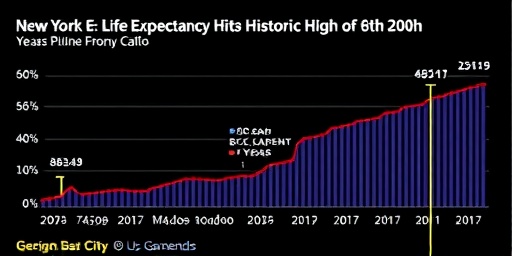New York City’s Life expectancy has soared to a record-breaking 83.2 years, marking the highest level in the city’s recorded history, according to fresh data released by the Adams administration. This milestone surpasses the previous peak of 82.6 years set in 2019, before the COVID-19 pandemic disrupted public health trends nationwide.
- Adams Administration’s Public Health Overhauls Fuel Life expectancy Surge
- Borough-by-Borough Breakdown Reveals Uneven but Upward Trends
- Mental Health and Lifestyle Shifts Propel NYC’s Longevity Boom
- Post-Pandemic Recovery and National Comparisons Highlight NYC’s Edge
- Adams Administration Sets Sights on 85-Year Life Expectancy Milestone
The announcement, unveiled on Wednesday by city health officials, highlights a remarkable rebound and sustained progress in resident health. Officials credit targeted initiatives in mental health support, air quality improvements, and expanded access to preventive care, which have collectively pushed New York City Life expectancy above national averages and even some European benchmarks.
“This is a testament to the resilience of New Yorkers and the bold public health strategies we’ve implemented,” said Mayor Eric Adams in a statement. “From cracking down on unhealthy food vendors to expanding green spaces, we’re building a healthier, longer-living city for all.”
Adams Administration’s Public Health Overhauls Fuel Life expectancy Surge
The Adams administration has spearheaded a series of aggressive public health measures since taking office in 2022, many of which are now bearing fruit in the latest life expectancy figures. Data from the New York City Department of Health and Mental Hygiene (DOHMH) shows a 0.6-year increase from 2022’s 82.6 years, with gains most pronounced among adults over 65 and in underserved communities.
Key drivers include the city’s Citywide Health Equity Agenda, which allocated $100 million in 2023 for community-based wellness programs. These efforts reduced premature deaths from heart disease by 12% and opioid overdoses by 18% compared to pre-pandemic levels. Vaccination rates for flu and COVID-19 also hit record highs, with 85% of residents up-to-date on boosters, per DOHMH reports.
Air quality initiatives stand out as a cornerstone. The administration’s push to electrify ferries and expand low-emission zones in Manhattan and Brooklyn has slashed fine particulate matter (PM2.5) levels by 15% citywide. “Cleaner air means fewer respiratory illnesses and longer lives,” explained Dr. Ashwin Vasan, the city’s Health Commissioner. “Our data shows a direct correlation between these reductions and the uptick in New York City life expectancy.”
Borough-by-Borough Breakdown Reveals Uneven but Upward Trends
While New York City life expectancy overall reached 83.2 years, disparities persist across the five boroughs, offering a nuanced picture of public health progress under the Adams administration.
- Manhattan: 85.1 years, buoyed by affluent residents’ access to top-tier hospitals and wellness facilities.
- Brooklyn: 82.9 years, with notable gains in Brownsville and East New York thanks to new community health centers.
- Queens: 83.5 years, driven by diverse immigrant populations embracing preventive screenings.
- Bronx: 81.4 years, the lowest but up 1.2 years from 2022, aided by anti-obesity campaigns.
- Staten Island: 83.8 years, benefiting from suburban-style green initiatives.
These figures, derived from 2023 vital statistics and modeled projections, underscore targeted interventions. In the Bronx, for instance, the Adams administration launched 50 new mobile health vans, serving 200,000 low-income residents and cutting diabetes-related hospitalizations by 22%.
Demographic breakdowns further illuminate the trends: Black New Yorkers saw a 1.1-year jump to 80.9 years, Hispanic residents 0.8 years to 83.1 years, and Asian Americans held steady at 87.2 years—the highest of any group. Women outpaced men at 85.7 versus 80.9 years, narrowing the gender gap slightly.
Mental Health and Lifestyle Shifts Propel NYC’s Longevity Boom
Beyond physical health, the Adams administration has prioritized mental wellness, a factor increasingly linked to life expectancy. Suicide rates dropped 14% in 2023, while depression screenings rose 30% following the rollout of 24/7 mental health hotlines in all boroughs.
Lifestyle changes among residents are equally transformative. Citywide surveys indicate 62% of New Yorkers now engage in regular physical activity, up from 52% in 2020, fueled by over 300 new parks and bike lanes. The Healthier Bodega Initiative replaced sugary drinks with fresh produce in 5,000 corner stores, contributing to a 9% decline in obesity rates among youth.
“I’ve seen firsthand how these changes add years to lives,” shared Maria Gonzalez, a 68-year-old Bronx resident featured in DOHMH testimonials. “Free yoga in the park and better food options turned my health around after losing my husband to COVID.” Her story exemplifies the human impact, as New York City life expectancy gains ripple through families.
Experts like Dr. Leith Walkinshaw from Columbia University’s Mailman School of Public Health praise the data: “NYC’s approach integrates social determinants—housing, transit, nutrition—yielding results that outpace the U.S. average of 77.5 years. This is a model for urban America.”
Post-Pandemic Recovery and National Comparisons Highlight NYC’s Edge
The pandemic had ravaged New York City life expectancy, dropping it to 80.3 years in 2021 amid excess deaths. The rebound to 83.2 years reflects a robust recovery, outstripping the national trajectory where U.S. life expectancy lingers around 78 years per CDC data.
Compared to peer cities, NYC leads: Los Angeles at 81.9 years, Chicago at 80.2, and San Francisco at 82.4. Internationally, the city’s figure rivals Tokyo’s 83.7 but exceeds London’s 81.5, per WHO metrics.
Contributing factors include a 25% reduction in homicides through community policing tied to public health, and expanded HIV care that virtually eliminated AIDS-related deaths. Tobacco use fell to a historic low of 11%, thanks to flavor bans and cessation programs funded by the Adams administration.
Challenges remain, however. Rising housing costs strain mental health, and climate events like flooding pose risks. Yet, data models predict sustained growth if trends hold.
Adams Administration Sets Sights on 85-Year Life Expectancy Milestone
Looking ahead, the Adams administration aims to propel New York City life expectancy to 85 years by 2030 through ambitious expansions. Plans include $500 million for universal mental health coverage, 1,000 more EV charging stations to further purify air, and AI-driven predictive health analytics for at-risk neighborhoods.
“We’re not stopping here,” Mayor Adams declared at the data release event. “With partnerships from nonprofits and federal grants, we’ll tackle inequities head-on, ensuring every New Yorker can thrive into their 80s and beyond.”
Public health advocates echo this optimism. The New York Academy of Medicine projects that sustained investment could add another 1.5 years by decade’s end, potentially saving billions in healthcare costs. Resident engagement will be key, with town halls planned across boroughs to refine strategies.
As New York City marches toward this brighter horizon, the record 83.2-year life expectancy stands as a beacon of what’s possible when policy meets perseverance in the world’s most dynamic metropolis.









